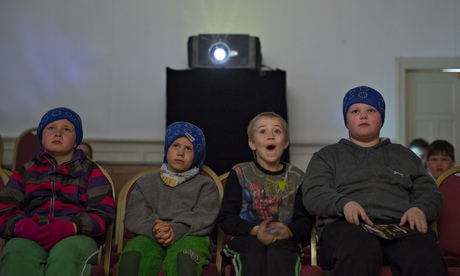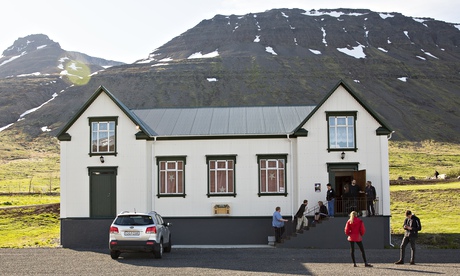Coming soon to a fjord near you … Iceland takes film to its extremities

Youngsters in the Icelandic village of Sudavik watch the Danish superhero film Antboy. Photograph: Brynjar Gunnarsson/Demotix
Up a steep flight of stairs at the back of the village hall in Sudavik is a small, largely abandoned box room, filled almost entirely by an old reel-to-reel film projector. From 1930, when the white-walled, green-roofed hall was built to serve the residents of this remote fishing settlement on Iceland's west coast, this is where the cinema was. "People used to come even if they'd seen the film," says Dagbjort Hjaltadottir, who still teaches at the village school. "Twice, sometimes even three times a week, it was where we met. It's what brought us together. That's important in a community. We still talk about it."
And then it stopped. Telly got better, eventually. Video then DVD arrived. People found other stuff to do. But today, on a sharp, still June morning with an already strong sun glancing off the snow-covered fells of the fjord, the cinema came back. It rolled up, to be exact, shortly after midday, in a silver minibus driven by Dora Magnusdottir, from the EU info-centre in Reykjavik. With her is Asa Baldursdottir, from Iceland's only arthouse cinema, Bio Paradis.
Also aboard were some sophisticated digital kit, a phlegmatic technician called Hylnur Fridriksson and two hardworking summer interns, Hans and Josephine Brinkmann – all eager, after a daunting drive through vast quantities of savagely beautiful but essentially uninhabited scenery, to show Sudavik (population: 150) a good film or three, for free.
This is Iceland's European film festival, a joint undertaking by the info-centre, which put up the money, and Bio Paradis, which provided a new portable digital projector. After two successful and rather more conventional festivals in the capital, the organisers decided this year to take a programme of three award-winning European films on the road, deep into Iceland's fastnesses – the places, in short, that even Icelanders consider remote. "There are so many isolated villages many hours' drive from a cinema," says Asa. "And more than 90% of the films actually distributed in Iceland are Hollywood. We're idealists at Bio Paradis. We believe in the power of great films – and we want more people to experience them."
So, on the face of it, do most of the villages around the country that the 10-day tour is visiting (selected, according to Dora, because they are "at least 200km apart and don't have ready access to any kind of cinema".)
That said, Olafsvik – the first stop and the most westerly settlement of its size in Europe – was a disappointment. But its 1,000-odd inhabitants can perhaps be forgiven: it was Monday night and they'd spent the weekend partying at their annual fishermen's festival. That, at any rate, was the explanation given by school chef Sigfus Almarsson, 59, one of just four villagers who made it to the evening screening of The Broken Circle Breakdown, Belgian director Felix van Groeningen's multi award-winning, Oscar-nominated, bluegrass-soaked drama from 2012.
"People are sleeping it off, I think," he said. "Myself, I wouldn't have missed it. How often do I get to see an art film? I can't remember the last time, that's how often. The nearest cinema to here is a day trip and it's a multiplex in a mall. Plus, I'm a big bluegrass fan."
But half the village turned up at Holmavik, the next stop, reached after a four-hour drive on often unsurfaced and always empty roads. "Oh look," said Dora somewhere between Bredobalstadur and Snoksdalur, "another car!" On we drove, past sprawling slopes of black scree, towering volcanic outcrops and seemingly endless snow-speckled lava fields, until we reached Holmavik, a fishing and shrimping village like Olafsvik, only smaller – just 375 people live here. Thirty excited and wildly face-painted children came along in pouring rain for the afternoon screening of Antboy, a witty and inventive take on the superhero movie by Danish director Ask Hasselbalch. Older teens sold popcorn, sweets and liquorice in the lobby of the 1970s concrete community centre, to raise money for the youth club.
"It was awesome," said 15-year-old Kristofer Birnir Gudmundsson, slightly shame-faced. A film about a 12-year-old boy who develops superpowers after being bitten by an ant was, after all, "a bit young for me, really. But look, I get to go to a cinema maybe twice a year. So it was great just to see this."
Ester Osp Valdimarsdottir and her husband, Eirikur Valdimarsson, had brought their children, Valdimar and Kormakur. "It's just brilliant that they thought of us," said Ester, while Eirikur recalled a school trip he had accompanied to Reykjavik last year. "Plenty of them – even 13- or 15-year-olds – had never even been to the cinema."
Not that there's nothing to do in Holmavik, of course. As Siggi Atlason, who runs its Museum of Icelandic Sorcery and Witchcraft, pointed out: "There's a choir, a theatre group who perform two plays a year, a library and music concerts." There's also the museum itself, which is remarkable in many ways. Do you, for instance, know what necropants are?
But there is no cinema. "Not for a long time," said Siggi. "There used to be one, once a week, on Thursdays. Everyone went, no matter what the film. But not for years." So much was cinema missed that in the wake of the 2008 financial crash that shook Iceland, Siggi organised a children's film club in the museum. "I was worried what it might be doing to them, the crash," he said. "I thought their imaginations should be busy with other things. There's something about sitting down, in darkness, in the quiet, everyone together. And then talking about it after, for days. It's not the same as the TV."
His sentiment was echoed by local historian Magnus Rafnsson and hotelier Vigdis Esradottir, after a packed showing of The Broken Circle Breakdown. "It really brings something to a community," said Magnus. "It's to do with it being an occasion, a collective experience," added Vigdis. "Although it would've been even better in the old village hall, the Nissen hut behind the cafe," said Magnus. "That's where the cinema used to be – and the dances." He paused. "A lot of memories there."

Sudavik villagers wait outside their hall to watch local boy Ragnar Bragason's feature Metalhead. Photograph: Brynjar Gunnarsson/Demotix
On, then, to Sudavik. Barely 50km away as the Icelandic raven flies, but more like five times that distance in the festival bus because the only road hugs the shore of five long fjords, like the fingers of a glove. Sudavik is famous in Iceland for the devastating avalanche that, at 6.25am on 16 January 1995, thundered down the side of the Sudavikurhlid mountain behind the town: 100m wide, 10m high and travelling at almost 100mph, it engulfed 22 houses and killed 14 people. After the disaster, more than 50 houses in the northern part of the town were declared unsafe for winter habitation. But, rather than move away, almost all their owners used their government compensation to build new homes in a safer area to the south.
Sudavik is also the home town of one of Iceland's more promising young film-makers, Ragnar Bragason, writer and director of three successful TV series and five feature films – including Metalhead, the third movie in our programme. So there is a sizeable turnout – a fifth of the village – for Bragason's lovingly observed, beautifully shot and very funny drama about a rebellious teenage girl on an isolated 1980s Icelandic farm, who turns to heavy metal for solace after her brother dies in a farm accident.
Teacher Dagbjort Hjaltadottir remembers Bragason as a seven-year-old pupil. "He was a creative lad, poetic even then." Valgeir Scott, a plumber, recalls babysitting him as a squawking infant. "It's just fantastic," says Hjaltadottir, "to bring these wonderful films here, and to this old hall , the heart of the village. This is really what cinema should be about, don't you think?"

Popcorn and soda on sale in Sudavik village hall. Photograph: Brynjar Gunnarsson/Demotix
Back in Reykjavik, over coffee in Bio Paradis, Ragnar Bragason agrees. "My first experience of cinema was in that hall – kids' films on Sundays. I grew up in that place and the idea for Metalhead sprang from its tragedy." said the film-maker, who was instrumental in getting Bio Paradis off the ground: boasting three screens, film literacy courses for schools, special events galore and a programme many independents in far larger towns would envy, its audiences are up 30% since it opened four years ago.
At 40, Ragnar is leading light in a film industry that produces – in a nation of 330,000 people – five or six features a year. His niece lost her two-year-old daughter in the avalanche, and dealt with it through art, just as the heroine of Metalhead turns to music. "It's basically the same mechanism," he says. "And the way Sudavik responded to that disaster – a small community pulling together, not apart – has a strong echo in the film too."
So Ragnar couldn't be happier that Iceland's European film festival has become "a cinema in a bus". It's important, he feels, "really important, in these very small communities. For me, where I come from, it's actually what it's all about – the essence of cinema."
• The European film festival ends on 10 June.
• Metalhead screens at the East End film festival, London, on 15 June.
